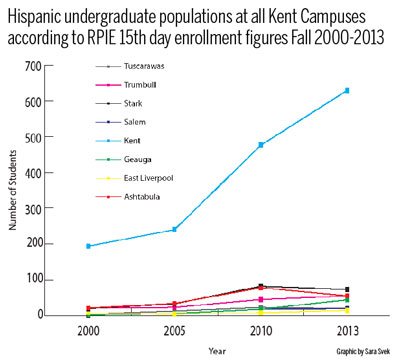Hispanic Heritage Month: A silent minority grows

September 15, 2013
Hispanic culture at Kent State has become relatively hidden with inactive organizations and low population, but despite what appears to be a relatively non-existent minority at Kent State, the number of undergraduate Hispanic students has actually dramatically increased in the last 23 years.
Today, only 629 undergraduate Hispanic students are enrolled at Kent State Main Campus compared to the 121 students enrolled in 1990, according to the 15th day enrollment figures from Research, Planning and Institutional Effectiveness and Student Inventory Data from the Uniform Information System for Ohio Board of Regents.
Fall 2013’s freshman class was the largest to enroll at Kent State, bringing 178 Hispanic freshmen to Kent State, according to enrollment figures.
THE RISING POPULATION
“I think the social norms are just changing. Basically more Latinos are trying to achieve just as much as any person in this society,” said Jinre Holman, Spanish and Latino Student Association (SALSA) president and junior accounting major. “They are trying to get a job, trying to get an education, trying to move up in the world, and as far as Kent being this little city, I don’t know how or where these people are coming from.”
Multicultural recruitment starts in the Kent State Admissions Office, where areas of high Latino populations are targeted for recruitment, said David Garcia, associate vice president of Enrollment Management and chair of the Latino Networking Caucus.
“[The Hispanic student increase] really goes to the strategy in which we are using outreach to AALANA populations,” Garcia said. “More or less, you have to go to the communities in which have a high population of Hispanic/Latino, African-American and Native American Indians and so forth, and to meet with the family and develop those relationships.”
High Latino populations near Kent State exist in Lorain, Ohio and western Cleveland.
Lorain’s Hispanic population also appears to be growing with no specific Hispanic reference in the city’s 1990 census, and then a recorded 16,177 Hispanic residents in 2010, according the U.S. Census Bureau and archived 1990 census documents from the University of Akron.
Oscar Ramos, assistant director of AALANA Initiatives, said he thinks the population is also rising because more people in general are seeking higher education.
“I’m not surprised. I’m actually pleased to see the growth in the Hispanic population [at Kent State],” Ramos said. “I have this notion that more people are embracing opportunity within the Latino culture, but I still think there are a lot of people who need help.”
THE CHANGING CULTURE
The organizations that are the leaders of Hispanic culture at Kent State just emerged within the last 23 years.
The Latino Networking Caucus (LNC) wasn’t established until 2010, Garcia said, and the organization of Kent State faculty, staff and non-voting student members interested in Latino culture has been trying to create programs and events students will appreciate.
In 2010, when LNC was established, 476 undergraduate Hispanic students were enrolled at the main campus, which is 153 less students than were enrolled this fall.
LNC has been working as liaison for Latino student organizations, such as SALSA, that have had trouble thriving at Kent State and basically remained unknown throughout the university’s history.
“[SALSA has] on years and off years in regards to who is in charge of the organization and how they try to recruit people and get people involved in the organization,” Holman said. “So I know we started in 1990, and there have been some ups and downs since.”
In 1990, when SALSA was established, only 121 Hispanic undergraduates were enrolled at the main campus and slowly increased to 141 in 1995 and then to 194 students in 2000.
The Hispanic undergraduate population dramatically increased within the last 13 years from 240 students in 2005, 476 in 2010 and now 629 students just three years later.
Read more about KSU’s Hispanic Heritage Month
Hispanic Heritage Month Festival commences a cultural celebration
The history of Kent State’s Hispanic Heritage Month
Hispanic Heritage Month facts and figures
Kent State movers and shakers in the hispanic community
Still, Hispanic organizations were not extremely active despite increasing to 476 undergraduate students the same year LNC formed.
“SALSA has been pretty inactive for about two or three years so we are really just trying to revamp it,” Holman said. “Last year was basically our starting point, and we made a lot of achievements last year.”
With the new emergence of SALSA, the organization started to reach out to students of all cultures last spring with a week of programming called Spice Up Your Life.
This year Holman said SALSA has had more than 100 students say they are interested in the organization and about 30 new members join meetings.
THE FUTURE
“I remember during my interview [for my current position] someone asking a question, ‘Why don’t we have Latino students here at Kent State when we are so close to Cleveland and the west side of Cleveland and Lorain?’” Garcia said. “And I asked the question, ‘Well what is Kent State doing to make students feel like we were expecting them, to make feel welcomed to the campus environment?’ And really no one had an answer.”
Now Hispanic organizations such as LNC and SALSA allow support for Hispanic students and people just interested in the Hispanic culture.
LNC and SALSA turned the tides around to get people thinking about who the Latinos are and what they are all about, Garcia said.
“The challenge is if you ask Latino students here at Kent State, they will more often than not say, ‘I didn’t know. I haven’t met anybody else Latino here. Where are the Latinos?’” Garcia said.
Contact Carley Hull at [email protected].











